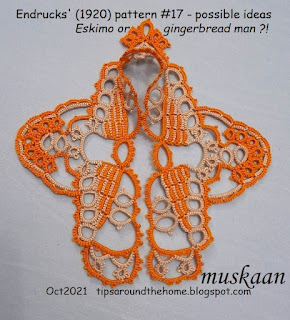Reworked patterns from Frau Eleonore Endrucks-Leichtenstern’s ‘Die Schiffchen-Spitzen’, 1920, for Endrucks 1920 Project.
Am
I getting too OC in my tatting? I can’t seem to stop tatting, telling myself
‘just one more repeat’ or ‘one more tweak’ or ‘now let’s place this colour
there’ to see what comes up - to upload the best possible for the pdf. But despite the time constraint I cannot stop
enjoying the tatting play – way cooler and way more exciting than bagatelle!
This time, though, I am very proud of my diagramming skill! In one single diagram I have managed to incorporate 3 versions of the pattern! To see it you will have to click on the pdf url - https://drive.google.com/file/d/1vG2g0JCVsy8cy2DfGKHEhxleq_7Rveba/view
These 5 pieces were tatted in a different sequence, spanning 2 years, to the one presented in the pdf. Here, I’d like to stick to my chronological timeline.
In order to incorporate the colour palette, lot of false CTM is used to transition to the next round instead of cutting both threads each time. And the thrown rings in one round were shifted to the next round and worked as regular rings.
This pattern modification is included in the diagram.
You can find Georgia Seitz’s written transcript and tips here - https://www.bellaonline.com/articles/art304446.asp
The count used in this piece is presented in the pdf in written format as well as in the diagram.
Empty 'hands' are a devil’s workshop ;-P I got to thinking that so far none of us has used Endrucks’ method of climbing out and was curious to see how it would look and compare! (I discovered only last week that Marina Mad Jar had already used it in pattern #34 - https://tipsaroundthehome.blogspot.com/2021/10/when-time-flies.html). Sep 2021 This is as close to the original count as possible, but using extra chains (shadow chains) to climb out à la Endrucks’.
Can you detect the Shadow chains used for continuous tatting? I deliberately chose ecru in size 40 trying to go for 'vintage'. If one uses 2 colours, some juggling might be called for, but in single colour it is easy-peasy! So, here’s an easy alternate for those who find split chains and split rings difficult to work.
Pattern #28 (3 versions) pdf - https://drive.google.com/file/d/1vG2g0JCVsy8cy2DfGKHEhxleq_7Rveba/view
Lining it with fabric would enhance the durability.
Choice of fabric colour will also help highlight each side. Different sides means the bag is easier to mix and match with your outfit, besides using up spare tatted lace. It can also be an exciting gift purse for a little girl!
As a reflection of Endrucks’ stacked chains (block tatting), I connected the 2 pieces using simple chains. By working alternate chains in direct tatting (reverse or unflipped stitches), it was a matter of one shuttle and ball, working continuously. Longer chains will obviously increase the capacity.
Lined the edges with beaded chain tatting for some bling. A large teardrop with beaded loop closes the opening, ....
....while those solid cylindrical beads finish off the handle. Good to hold a ball or 2 and shuttles for a project on the go!
Although there's many a slip 'twixt the cup and the lip, ‘twixt my conception and execution, and nowhere as elaborate as Anita’s, I am happy with my first such bag-a-ball baggie!
**********************
Endrucks 1920 Project is a community project, we welcome every one of you to
join in! Please let us know where we can find your renditions and derivative
tatting!
We created the hashtag #Endrucks1920Project, so please use it for your version to show up in a search.
We all enjoy sharing and the project is awaiting every one of you!
All info and links (original and modern) are in the Endrucks 1920 Project
Document, here:
https://docs.google.com/document/d/17LEVftXweztBIOWh4sL4BB7bX65ssoOsOn4oXIgCepY/view
Remember there are many more modernised patterns, derived and extracted
patterns/ideas, already listed in the project document, with more still to
come! So, do visit and scroll through.
*********************
































